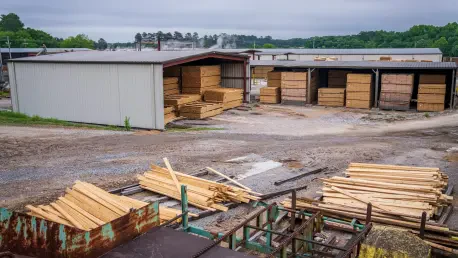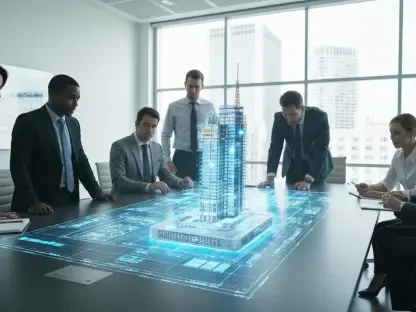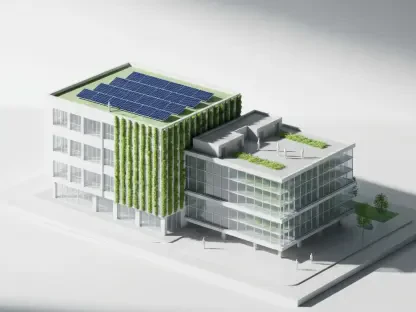As the demand for sustainable structures surges globally, the search for efficient and eco-friendly HVAC solutions has intensified exponentially. Among the promising contenders in this quest are chilled beam systems, which have captured the attention of architects, builders, and environmental advocates alike. With projections estimating the market value to soar to USD 3.8 billion by 2032, driven by a robust compound annual growth rate of 7.41%, the chilled beam industry epitomizes the significant shift toward energy conservation and climate control optimization within modern architecture. By utilizing chilled water to efficiently climatize spaces, these systems offer an innovative alternative to conventional HVAC solutions, emphasizing reduced energy consumption and minimized operational costs. Their ability to maintain preferable indoor climates with lower airflow not only augments energy efficiency but also paves the way for quieter and more harmonious indoor environments. This effective blend of benefits has positioned chilled beams as a pivotal component in achieving sustainable energy goals across commercial, healthcare, and educational infrastructures.
Emergence of Chilled Beam Systems
Chilled beam systems have increasingly become synonymous with cutting-edge energy efficiency and sustainability in modern building designs. These sophisticated systems utilize chilled water to effectively cool or heat indoor spaces, marking a radical departure from traditional HVAC methods reliant on extensive airflow and mechanical components. By leveraging water’s superior heat transfer capabilities, chilled beams consume significantly less energy, thus providing a cost-effective and environmentally friendly alternative for climate control. Their innovative design ensures that spaces remain comfortably cool or warm with minimal noise and disruption, thereby enhancing the overall quality of indoor environments. This seamless integration into various architectures makes them highly adaptable to diverse applications, including commercial offices, educational facilities, healthcare settings, and hospitality venues.
Notably, the growing importance of chilled beams is underscored by their alignment with global energy conservation goals and sustainability certifications. Green building frameworks such as LEED and BREEAM emphasize the need for energy-efficient systems, spurring the adoption of technologies that contribute positively to shrinking carbon footprints. Chilled beams, known for their reduced reliance on mechanical ventilation, are well-suited to meet these rigorous standards, offering facility managers and designers a viable path to achieve certification and recognition for their eco-conscious endeavors. As a result, chilled beam systems are transforming into essential constituents of green architecture, facilitating the transition toward environmentally sustainable construction practices.
Compounding this growth trajectory, innovative designs and developments in chilled beam technology continue to expand their applicability and appeal. The market boasts a diverse range of systems, including active, passive, and hybrid models, each engineered to serve specific climatic needs and operational requirements. While active chilled beams integrate effectively with existing ventilation systems to optimize thermal performance, passive beams offer simplicity and low maintenance, making them ideal for quieter spaces. Hybrid systems, which amalgamate the attributes of active and passive beams, present yet another dimension of adaptability for projects requiring versatility. By offering a plethora of options, chilled beam systems ensure there is a specialized solution to meet the unique demands of each building type and geographical setting.
Market Dynamics and Influences
The immediate and long-term prospects of the chilled beam market are being buoyed by a confluence of factors that prioritize sustainability and operational efficiency. One of the defining influences remains the relentless global push towards more responsible energy management and lower emissions within the built environment. Building managers and engineers are under increasing pressure to deliver solutions that not only enhance comfort and air quality but also reduce the carbon footprint associated with heating and cooling. This imperative is further amplified by stringent environmental regulations that necessitate a move towards greener infrastructure, prompting developers and owners to seek HVAC solutions that align with contemporary eco-friendly philosophies.
A core component contributing to the success of chilled beam systems is their seamless fit within the paradigm of smart building technologies. The integration of building automation systems and smart sensors with chilled beams facilitates more precise and intelligent temperature control, thereby enhancing energy savings and user comfort. As adaptive systems continue to evolve, these integrations enable the crafting of responsive environments that automatically adjust to shifting ambient conditions and occupancy levels. Such capabilities not only promise heightened energy efficiency but also ensure that chilled beam systems remain at the forefront of innovative HVAC solutions, delivering optimal performance in real-time scenarios.
An integral aspect driving chilled beam adoption is its endorsement by green building certifications and initiatives, which underscore the necessity for low-carbon solutions in modern developments. Recognition through certifications not only promotes wider acceptance but also incentivizes adoption by demonstrating tangible benefits, including lower energy bills and improved indoor environments. This acceptance is proving pivotal in overcoming the prevalent challenges of high installation costs and climatic restrictions, by providing a clear framework of best practices and benchmarks for achieving high-performance results. Notably, real estate stakeholders recognize the added value these systems offer in terms of compliance with energy and sustainability directives, enhancing the marketability and appeal of properties that demonstrate leadership in environmental responsibility.
Geographical Trends and Innovations
Geographical trends in the chilled beam market reflect the varied yet converging priorities of regions aiming to enhance their environmental credentials. North America stands out as a leader in chilled beam adoption, fueled by government mandates advocating energy efficiency and a strong push for green building initiatives. The concerted efforts to improve indoor air quality also bolster market demand across the continent. In parallel, Europe demonstrates significant engagement, propelled by its longstanding commitment to eco-friendly construction. Stringent regulations and widely embraced sustainable practices serve as key drivers in European markets, where countries like Germany, the UK, and the Nordic region continuously champion innovative and low-impact building techniques.
Contrasting yet complementary growth is seen in the Asia-Pacific region, where a rapid pace of urbanization and infrastructure development gives rise to an expanding demand for chilled beam solutions. Nations such as China, India, and Japan are increasingly incorporating environmentally sustainable practices into their urban planning agendas, thus opening a lucrative frontier for chilled beam systems. The alignment of government policies with urban growth initiatives supports the burgeoning implementation of advanced HVAC methodologies, driving significant market expansion within this region. The adaptability and energy-saving potential of chilled beam systems cater to the pressing needs of emerging and densely populated urban landscapes.
Technological innovation further solidifies the chilled beam market’s trajectory, enhancing its functionality and applicability. Breakthroughs in materials science and design have allowed for the development of Multi-Service Chilled Beams (MSCBs), which merge various building systems such as lighting, sprinklers, and sensors into a compact unit. These integrated designs optimize space utilization and harmonize infrastructure elements, resonating well with modern smart buildings and densely packed environments. As these technological advances continue to evolve, with heightened cooperation between HVAC providers and building system integrators, the market outlook remains distinctly positive, underscoring chilled beams’ increasingly inextricable role within sustainable building strategies.
Future Outlook and Implications
Chilled beam systems are increasingly recognized for their energy efficiency and sustainability in contemporary building design. These advanced systems utilize chilled water for climate control, offering a modern alternative to traditional HVAC systems that depend heavily on airflow and mechanical components. By harnessing water’s ability to transfer heat more effectively, chilled beams significantly reduce energy consumption, making them both cost-effective and environmentally friendly. Their design ensures indoor spaces are comfortably cooled or heated with minimal noise, thereby enhancing the quality of indoor environments. This capability makes them adaptable for use in various structures, from commercial offices to educational, healthcare, and hospitality facilities.
The importance of chilled beams is highlighted by their alignment with global energy conservation goals and sustainability certifications like LEED and BREEAM. These frameworks stress energy-efficient systems, encouraging the adoption of technologies that minimize carbon footprints. Chilled beams, with their reduced dependence on mechanical ventilation, meet these standards, offering facilities a path to certification and eco-friendly recognition.
The technology behind chilled beams is evolving, expanding their appeal. The market offers diverse systems, including active, passive, and hybrid models, each designed for specific climatic needs. Active beams integrate with existing systems to boost thermal performance, while passive beams require minimal maintenance. Hybrid systems combine features of both, providing versatility for varied projects. With such options, chilled beam systems offer tailored solutions to meet the distinct needs of different buildings and locations.









